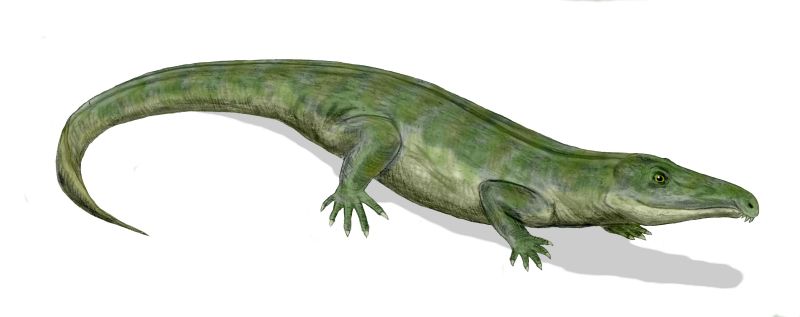[Recent Entries][Archive][Friends][User Info]
| February 19th, 2012 | |
|---|---|
| 12:05 pm [industrialterro] [Link] |
Proterosuchus Proterosuchus is an extinct genus of Early Triassic proterosuchid archosaur. Remains have been found from South Africa and China. The genus Chasmatosaurus is considered a junior synonym of Proterosuchus, as all species of Chasmatosaurus, including C. aleandri, C. vanhoepeni, and C. yuani, have been reassigned to Proterosuchus. Elaphrosuchus has also been synonymized with Proterosuchus. The type species of Proterosuchus is P. fergusi. Two other species, P. ultimus and P. yuani, have also been named. Proterosuchus was one of the largest land reptile during the Early Triassic period, equivalent in size to today's Komodo dragons. It looked somewhat similar to a primitive crocodile, and shared many of their modern features like long jaws, powerful neck muscles, short legs and a lengthy tail, while possessing several features unique to proterosuchids such as its hook-shaped mouth. This jaw may have been an adaptation for catching prey, such as the dicynodont Lystrosaurus. Proterosuchus, like most modern crocodiles, is theorised to be an ambush predator, waiting for its prey to enter the water, at which point they would be attacked from below the surface, using the long, muscular tail for swimming and pushing through the water at speed. However, the animal also had stout legs that enabled it to walk comfortably at land. Being able to move between the land and the water was a great advantage, and enabled Proterosuchus to control its body temperature by sunbathing or cooling off in the water. Being an ambush predator like some present-day crocodiles meant that for the most part Proterosuchus remained in one environment for most of its life. This worked as an excellent means of conserving energy, even giving it the capability of surviving for perhaps months at a time without food. Although it could live and swim in the water, Proterosuchus may have preferred to hunt land animals rather than fish. Its eyes were located on the top of its head, allowing it to hide just under the surface of the water, where it would wait for animals to come and drink. When close enough, Proterosuchus would spring upwards and drag its victim into the water, drowning and then eating it. Comparisons between the scleral rings of Proterosuchus and modern birds and reptiles indicates that it may have been cathemeral, active throughout the day during short intervals, supporting the idea that early archosaurs adapted to dim light. However, as Proterosuchus may have been a polar animal, it likely lived under different lighting conditions from typical archosaurs and may not have inherited such adaptations from a common ancestor with archosaurs. Proterosuchus is an example of an early archosaur, the group which encompasses crocodiles, pterosaurs, dinosaurs, and birds. It was once believed to have been an ancestor to the crocodilians, but it is now known to be far more basal. Протерозух (Proterosuchus) — описан Р. Брумом из раннего триаса (зона Lystrosaurus) Южной Африки в 1903 году. Типовой вид — P. fergusi. Это же животное было позднее описано Хаутоном как хасматозавр (Chasmatosaurus vanhoepeni). Длина черепа от 15 до 50 см. Вероятно, остатки протерозухов принадлежали более мелким молодым особям, тогда как «хасматозавры» — более крупные животные. Череп низкий, с длинной мордой. Телосложение относительно легкое, зубы длинные, изогнутые назад. Вероятно, полуводный хищник, охотник за мелкой добычей. Близкий вид (P. yuani) описан в 1936 году из одновозрастных отложений Китая.
Tags: Вымершие рептилии, Триас, архозавроморфы, диапсиды, протерозухии, текодонты |




